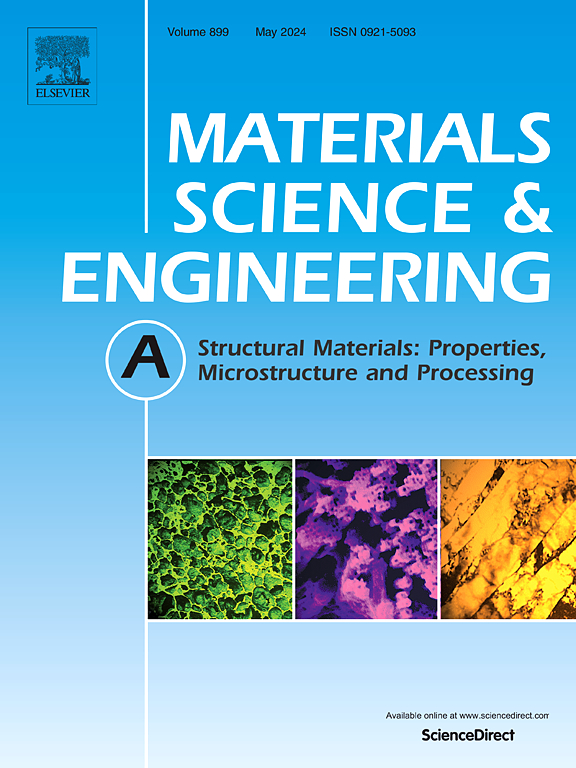超细铌粉实现了元素粉末冶金NiTi形状记忆合金的协同液相烧结全致密化
IF 7
2区 材料科学
Q1 MATERIALS SCIENCE, MULTIDISCIPLINARY
引用次数: 0
摘要
元素粉末冶金(EPM)是制备NiTi形状记忆合金的一种经济有效的方法。然而,由于Kirkendall气孔和Ni-Ti二元液相不受控制的泄漏,在EPM NiTi合金中实现完全致密化仍然具有挑战性。本研究引入细Nb粉末制备了NiTi-Nb三元共晶液相。该策略有效抑制了随机二元Ni-Ti液相引起的反致密效应,实现了接近完全致密化(相对密度>; 99%),显著提高了综合力学性能(抗压强度为3051 MPa,断裂应变为39%,8%预应变下的形状恢复率为70.0%)。与粗Nb粉末相比,细Nb颗粒的使用促进了均匀分布的共晶液相更早、更完整的形成。这种增强源于热力学因素(通过吉布斯-汤姆森效应增加局部反应驱动力,降低局部熔点)和动力学因素(加速扩散和增加成核位置)与颗粒细化相关的协同相互作用,通过减小颗粒曲率半径和缩短扩散路径来实现。因此,显微组织均匀性和致密性都得到了改善。因此,控制液相的生成和均匀的空间分布被认为是决定EPM镍钛基合金实现高密度化可行性的关键因素。这项研究为开发低成本、高性能的镍钛基合金提供了一种新的解决方案,适用于生物医学植入物、密封和耦合等领域。本文章由计算机程序翻译,如有差异,请以英文原文为准。

Ultrafine niobium powder enabled synergetic liquid-phase sintering toward full densification of elemental powder metallurgy NiTi shape memory alloys
Elemental powder metallurgy (EPM) represents a cost-effective approach for fabricating NiTi shape memory alloys. However, achieving full densification in EPM NiTi alloys remains challenging due to Kirkendall pores and the uncontrolled leakage of the Ni-Ti binary liquid phase. This study introduced fine Nb powder to generate a ternary NiTi-Nb eutectic liquid phase. This strategy effectively suppressed the anti-densification effect caused by the random binary Ni-Ti liquid phase, enabling near-full densification (relative density >99 %) and significantly enhancing the comprehensive mechanical properties (compressive strength was 3051 MPa, fracture strain was 39 %, shape recovery ratio under 8 % pre-strain was 70.0 %). Compared to coarse Nb powder, the use of refined Nb particles promoted the earlier and more complete formation of a uniformly distributed eutectic liquid phase. This enhancement stems from the synergistic interplay of thermodynamic (increased local reaction driving force via the Gibbs-Thomson effect, lowering the local melting point) and kinetic (accelerated diffusion and increased nucleation sites) factors associated with particle refinement, achieved by reducing the particle curvature radius and shortening diffusion paths. Consequently, both microstructural homogeneity and densification were improved. The controlled generation and uniform spatial distribution of the liquid phase are thus identified as critical factors determining the feasibility of achieving high densification in EPM Ni-Ti-based alloys. This study provides a novel solution for the development of low-cost, high-performance Ni-Ti-based alloys suitable for applications such as biomedical implants, sealing, and coupling fields.
求助全文
通过发布文献求助,成功后即可免费获取论文全文。
去求助
来源期刊

Materials Science and Engineering: A
工程技术-材料科学:综合
CiteScore
11.50
自引率
15.60%
发文量
1811
审稿时长
31 days
期刊介绍:
Materials Science and Engineering A provides an international medium for the publication of theoretical and experimental studies related to the load-bearing capacity of materials as influenced by their basic properties, processing history, microstructure and operating environment. Appropriate submissions to Materials Science and Engineering A should include scientific and/or engineering factors which affect the microstructure - strength relationships of materials and report the changes to mechanical behavior.
 求助内容:
求助内容: 应助结果提醒方式:
应助结果提醒方式:


